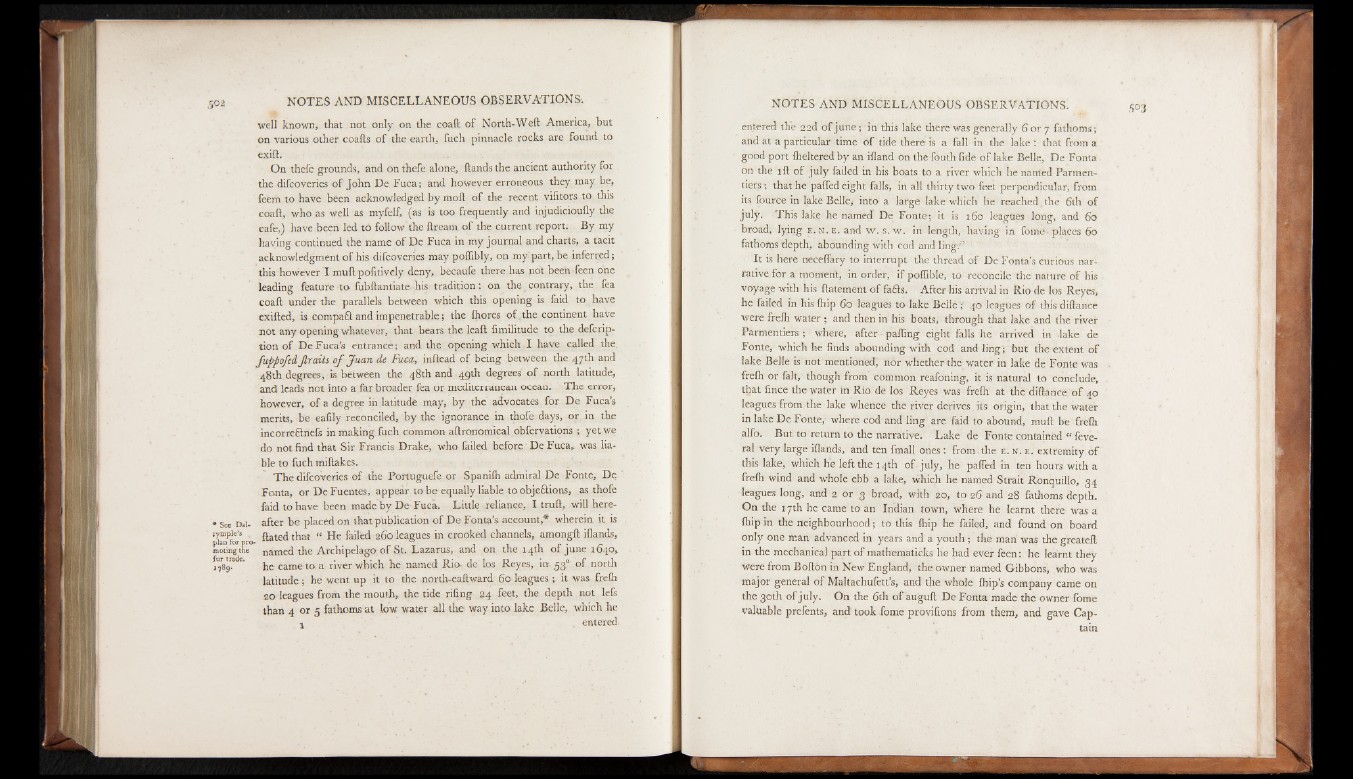
well known, that not only on the coaft of North-Weft America, but
on various other coafts of the earth, fuch pinnacle rocks are found to
exift.
On thefe grounds, and on thefe alone, Hands the ancient authority for
the difcoveries of John De Fuca; and however erroneous they may be,
feem to have been acknowledged by moll of the recent vilitors to this
coaft, who as well as myfelf, (as is too frequently and injudicioufly the
cafe,) have been led to follow the ftream of the current report: By my
having continued the name of De Fuca in my journal and charts, a tacit
acknowledgment of his difcoveries may poftibly, on my' part, be inferred;
this however I muft politively deny, becaufe there has not been teen one
leading feature to fubftantiate his-tradition: on the contrary, the fea
coaft under the parallels between which this opening is faid to have
exifted, is compaft and impenetrable; the Ihores of „the continent have
not any opening whatever, that bears the leaft fimilitude to the defcrip-
tion of De Fuca’s entrance; and the opening which I have called the,
Juppofed, Jlraits o f Juan de Fuca, inftead of being between the 47th and
48th degrees, is between the 48th and 49th degrees o f north latitude,
and leads not into a far broader fea or mediterranean ocean. The error,
however, of a degree in latitude may, by the advocates for De Fuca’s
merits, be ealily reconciled, by the ignorance in thofe days, or in the
incorreftnefs in making fuch common aftronomical obfervations ; yet we
do not find that Sir Francis Drake, who failed before De Fuca, was liable
to fuch miftakes.
The difcoveries of the Portuguefe or Spanith admiral De Fonte, De
Fonta, or DeFuentes, appear to be equally liable to objections, as thofe
faid to have been made by De-Fuca. Little reliance, I truft, will hereafter
be placed on that publication of De Fonta’s account,* wherein it is
ftated that “ He failed 260 leagues in crooked channels, amongft iflands,
named the Archipelago of St. Lazarus, and on the 14th of june 1640,
he came to a river which he named Rio de Los Reyes, in, 53“ of north
latitude; he went up it to the north-eaftward 60 leagues; it was freflt
20 leagues from the mouth, the tide riling 24 feet, the depth not lefs
than 4 or 5 fathoms at low water all the- way into lake Belle, which he
j . entered;
* See Dalrymple’s
jj
plan for promoting
the
fur trade.
1789.
entered the 22d of june ; in this lake there was generally 6 or 7 fathoms ;
and at a particular time of tide there- is a fall in the lake : that from a
good port Iheltered by an ifland on the fouth fide of lake Belle, De Fonta
on the tft of july failed in his boats to a river which he named Parmen-
tiers ; that he palfed eight falls, in all thirty two feet perpendicular, from
its fource in lake Belle, into a large lake which he reached, the 6th of
july. This lake he named De Fonte; it is 160 leagues long, and 60
broad, lying e . n . e . and w. s .w . in length, having in fome-places 60
fathoms depth, abounding with cod and ling/’
It is here necelfary to interrupt the thread of De Fonta’s curious narrative
for a moment, in order, if poflible, to reconcile the nature of his
voyage with his ftatement of fafts. After his arrival in Rio de los Reyes,
he failed in his {hip 60 leagues to lake Bella ; 40 leagues of this diftance
were frelh water ; and then in his boats, through that lake and the river
Parmentiers ; where, after - pafling eight falls he arrived in lake de
Fonte, which he finds abounding with cod and ling; but the extent of
lake Belle is not mentioned,' nor whether the water in lake de Fonte was
frelh or fait, though from common reafoning, it is natural to conclude,
that fince the water in Rio de los Reyes was frelh at the diftance o f 40
leagues from the lake whence the river derives its origin, that the water
in lake De Fonte, where cod and ling are faid to abound, muft be frelh
alfo. But to return to the narrative. Lake de Fonte contained “ lèverai
very large iflands, and ten final! ones : from - the e . n . e . extremity of
this lake, which he left the 14th of july, he palfed in ten hours with a
frelh wind and whole ebb a lake, which he named Strait Ronquillo, 34
leagues long, and 2 or 3 broad, with 20, to 26 and 28 fathoms depth.
On the 17 th he came to an Indian town, where he learnt there was a
Ihipin the neighbourhood; to this Ihip he failed, and found on board
only one man advanced in years and a youth ; the man was the greateft
in the mechanical part of mathematicks he had ever feen: he learnt they
were from Bofton in New England, the owner named Gibbons, who was
major general of Maltachufett’s, and the whole Ihip’s company came on
the 30th of july. On the 6th of auguft De Fonta made the owner fome
valuable prefents, and took fome provifions from them, and gave Cap